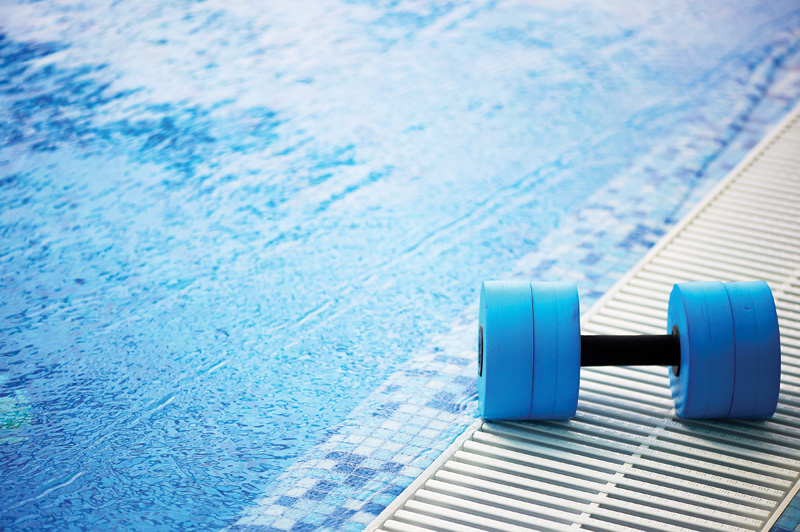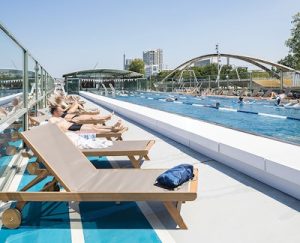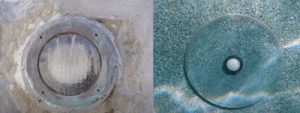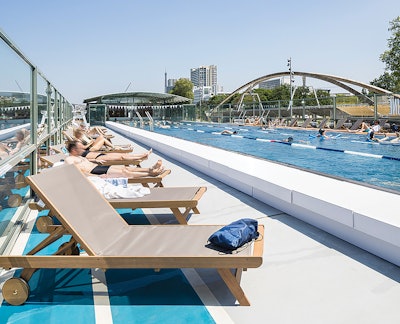By Farheen Sikandar
As the demand for inclusive fitness solutions in the pool industry continues, builders and manufacturers must develop and create rehabilitation and exercise equipment accommodating individuals with diverse abilities, from athletes to children needing pediatric therapy. This approach ensures the products effectively meet the needs of all users, which can also aid in the increase in demand for pools, spas, and accessories.
Water-based rehabilitation, also known as aquatic therapy or hydrotherapy, is often recommended for individuals who can benefit from water’s unique properties to aid in recovery, pain management, or improving mobility. It is particularly effective because water provides buoyancy, reduces the impact of gravity, and allows for a controlled environment to perform therapeutic exercises.
When selling pools and swim spas, informing potential customers about the various benefits of hydrotherapy can help enhance sales. Before diving into the products that aid in water rehabilitation, it is important to know the benefits of aquatic fitness:
- Aquatic exercise programs consist of low-impact movements performed underwater that mimic traditional aerobics. Similar to swimming, these exercises can enhance muscle strength, flexibility, and cardiovascular health. They also promote better balance, posture, and co-ordination. Aquatic exercises provide a great pool-based alternative for family members who are either uncomfortable in the water or not strong swimmers, as they are typically conducted in constant-depth pools or the shallow end of a traditional pool.
- Water’s buoyancy reduces the effects of gravity on the body, making a person feel lighter when submerged. This buoyancy also minimizes the impact on bones, muscles, joints, and ligaments. When swimming in deep water, the body experiences virtually no impact. This is beneficial for sore muscles, aiding in injury recovery and assisting those who struggle with movement on dry land.
- Movement underwater encounters increased resistance due to water’s density. This resistance also reduces the impact of specific movements on joints, making sudden stops and starts less painful than they would be out of water.
- Water can also help cool bathers down during workouts in a pool or swim spa. As swimmers move through the water, their sweat is removed, which helps prevent overheating and effectively eliminates excess heat.
- Water exerts hydrostatic pressure on the body. Hydrostatic pressure is the pressure exerted by any fluid in a confined space. This pressure increases circulation, which helps reduce swelling.
Equipment
Aquatic treadmills
Pool treadmills can elevate the appeal of any facility. This accessory uses the buoyancy of water to its benefit and offers more elasticity, making jogging easier on the joints. It is ideal for low-impact movements. When underwater rehabilitation is recommended, a pool treadmill is essential.
Like a regular treadmill, this lightweight equipment has a wide walking surface, often removable handlebars, and built-in wheels. It can usually be removed and placed in a pool with ease. These treadmills are made with durable materials such as stainless steel that allow full submersion in pool water. Due to the water submersion factor, they are also often non-motorized.
In the treadmill realm, hydrotherapy machines are also commonly used in vet clinics.1 These include a built-in treadmill floor within a steel box, allowing users to control the water depth, temperature, and cycle speed. These machines can also feature jets to create turbulence, which helps generate more exertion.
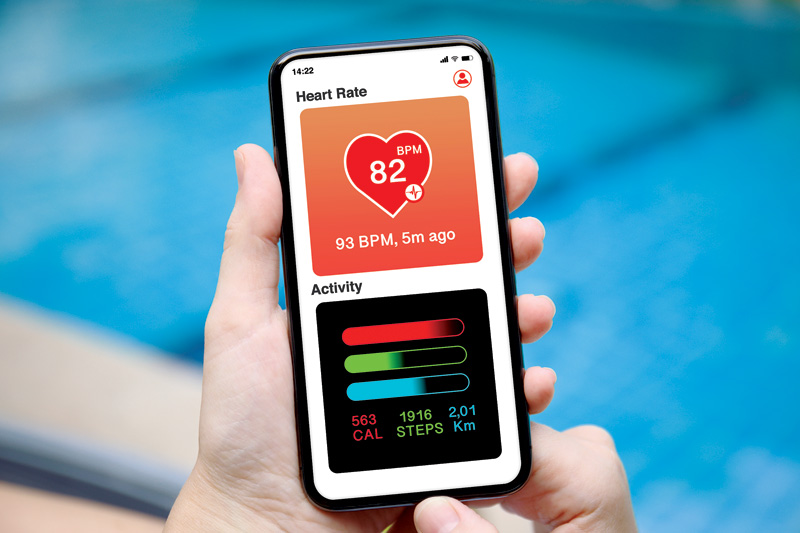
Aquatic bikes
A lightweight stationary bike for underwater use can come with ergonomic features. It can include silicone alongside the anti-skid padded pedals to better grip the feet. Silicone on the wheels can also help in protecting the pool liner. Much like underwater treadmills, aquatic bikes are also non-motorized; one has to peddle faster for added resistance. These bikes can be made of stainless steel or aluminum. Some manufacturers make these bikes in unique shapes, which allows them to be foldable. There is also the option of offering various seating, from rehabilitation-specific to sports-related.
These underwater products are also an avenue to showcase any coatings or paints and showcase their waterproof and anti-rust qualities.
Resistance jets
An essential part of hydrotherapy is a high-quality jet system. Pressurized jets help massage muscles and soft tissues.2 There are multiple kinds of jets, for example:
- Rotational jets—Pushes water out in a circular spinning motion for targeted massages.
- Directional jets—Directs water in a steady stream, and the intensity and direction can be adjusted.
- Whirlpool jets—High-pressured jets that create a swirling effect. Ideal for deep-tissue massage.
- Air jets—Releases many tiny air bubbles for a gentle massage. The intensity can be adjusted.
- Pulse stream jets—Bursts out water and pauses in intervals, creating a pulsing effect.
- Cluster jets—A group of small jets targeted for a specific function (e.g. foot massage).
- Seat jets—Jets integrated into seating areas to provide targeted soothing massage for the back, hips, and thighs.
- Swimming jets—High-pressured jets that create resistance. Ideal for swim training as it gives the experience of using a lap pool.
Various types of jets serve distinct functions that can be customized to meet specific therapeutic needs, such as relaxation, pain relief, or muscle recovery. Today’s hydrotherapy systems often enable users to adjust the intensity and position of the jets and the water temperature to ensure optimal comfort.
Ensuring jets use energy-efficient pumps can also be a selling point for projects that want to integrate environmentally conscious strategies.
Additionally, when designing for spas or other aquatic facilities, it is important to consider chlorine-free or saltwater-compatible designs.
Plunge pool
The benefits of cold plunges are plentiful, such as reduced soreness and muscle recovery. Cold plunges are the practice of submerging oneself in cold water. They are popular for spas, hydrotherapy, and athletes. Sold with a chiller, cold tub plunges can also serve as a dual product, as they work as a hot tub with the addition of a heater. They also come with self-cleaning systems (e.g. ozone sanitation/purification) and a filter circulation system for easier maintenance and use.
Cold plunge tubs are also great for showcasing insulated covers and accessories such as LED lighting. The most advanced options offer control via Wi-Fi alongside touchscreens.
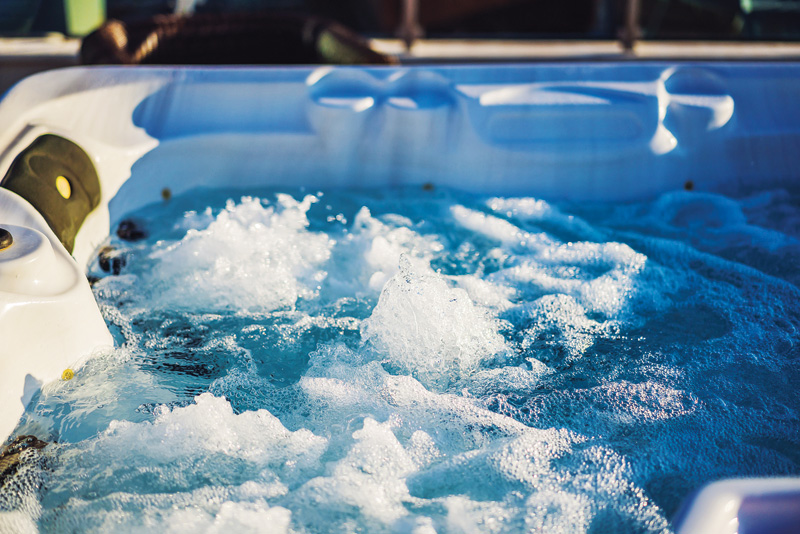
Floating mats
A floating mat helps with yoga or balancing exercises on water. These mats are inflatable and wide enough to perform exercises or relax by lying down. They are also thick enough to provide additional buoyancy to withstand any intense movements. When manufacturing, it is important to note that these exercise mats should be able to support heavy weights. They should also have a non-slip surface and use UV- and chlorine-resistant materials. Floating mats also often have multiple handles for better grip. Some manufacturers offer detachable fins for these mats or experiment with different ethylene vinyl acetate (EVA) patterns that enhance the grip. A key factor of this equipment is a pump that provides quick inflation.
Swimmers who are overweight, elderly, or suffer from ailments such as arthritis, fragile bones, injuries, or other disabilities can all benefit from movement in the water. Equipment such as special lifts, aquatic chairs, stairs, and ramps can help them easily access the pool, which is an important consideration.
Accessories
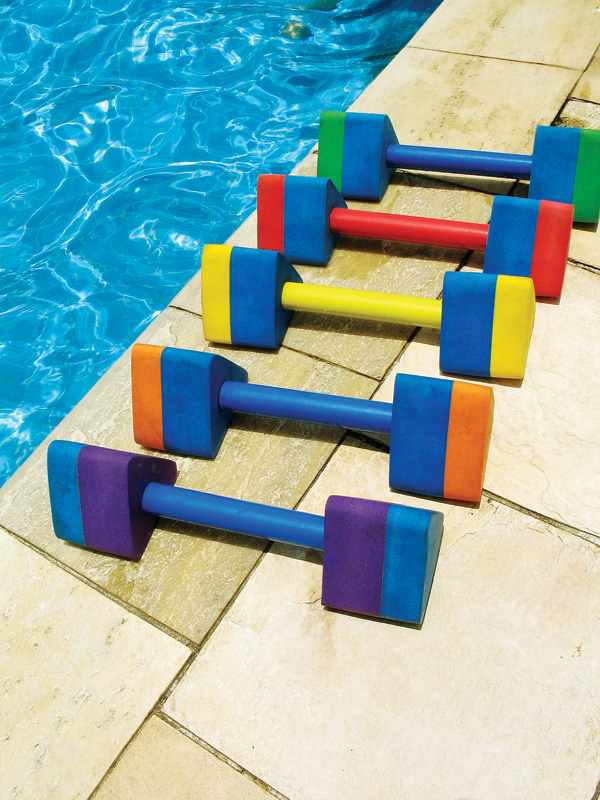
Aquatic dumbbells
Commonly known as yoga dumbbells, these are great for muscular or static workouts, including toning and strength exercises. Sold in pairs, they are commonly made of EVA, a closed-cell foam that has strong UV resistance and low water and moisture absorption.3 These dumbbells have a large diameter, are often chlorine-resistant, dry quickly, and the flexible material allows for various shapes (e.g. circles, diamonds, triangles, etc.). EVA makes these dumbbells lightweight, and the cushioning properties provide a comfortable grip.
Due to its waterproof properties, EVA is a popular material for pool noodles, floats, and other aquatic fitness tools such as cuffs (wrists and ankles) and exercise disks.
Some manufacturers sell all these accessories in a kit, which includes dumbbells, cuffs, disks, swimming belts, and gloves.
Resistance gloves and swim fins

Swim gloves are popular for aqua aerobics and upper body exercises focusing on strength. Often webbed, they create resistance and are ideal for swim training. Some designs feature open tops without fully covered fingers, allowing users to feel the water. Some designs also include only the webbed finger bits. Common materials for this accessory are silicone, rubber, and neoprene (synthetic rubber). The gloves usually have a Velcro strip for easy adjustment.
Swim fins are footwear resembling fins—the fins can be stiff or flexible, depending on the swimmer’s needs and the material’s density. Swim fins are often made of rubber, EVA, or silicone and have many design options, including long or short blades and different blade angles. Some blades create a “spoon” effect when in water, some are tilted at specific angles, and some are rigid to slice through water.
The foot pocket in swim fins also varies. Some have enclosed fins, supporting the foot’s natural position, and some have open fins, allowing the ankle more flexibility. Swim fins are ideal for snorkelling, diving, and swim training. This accessory should be offered in multiple sizes.

Jogger belt
This device keeps the user afloat in water, offering balance and added safety. With a traditional buckle design, it often uses EVA. Some have an expanded polyethylene (EPE) lining with a nylon strap. Manufacturers also sell this product with features like a zippered pocket. This floatable device is easily portable and can be used in many rehabilitation exercises.
Steppers

Made for underwater stepping exercises, aquatic steppers come in varying heights and have an anti-slip surface on top (likely polyvinyl chloride [PVC] or rubber). They are usually made of high-density polyethylene. They can be one whole product or multiple products, with the risers and platform being separate, allowing users to adjust the height. These steppers should be corrosion-, chemical-, and chlorine-resistant. Ensuring these qualities in a product indicates it is long-lasting.
Smart integration
In the digital era, one must consider technological advances in their products. For accessories, consider waterproof wearable sensors that track movement, heart rate, calories burned, step count, etc.
In-pool sensors can help track water temperature, dust and debris, pressure near jets, chlorine levels, and information such as water depth and buoyancy levels. Integration with mobile apps for real-time tracking is helpful when using these sensors. Apps can also allow data customization to a user’s specific needs; for example, voice commands can guide users with accessibility needs. This is where artificial intelligence (AI) can step in, as it makes personalized recommendations quite well.
Pool cameras are helpful in monitoring movement during aquatic exercise.
Conclusion
As aquatic therapy continues to evolve, it is essential to integrate innovative equipment and accessibility features to meet the needs of diverse users. Advanced technologies such as resistance jets, aquatic treadmills, and smart sensors paired with applications provide tailored rehabilitation, fitness, and relaxation solutions.
By embracing inclusive designs and harnessing water’s therapeutic benefits, the pool and spa industry can drive demand while ensuring its products serve all demographics, including individuals recovering from injuries, athletes, and those with limited mobility.
Careful attention to materials, functionality, and environmental compatibility further enhances the value of pools and spas, creating a comprehensive offering for modern aquatic facilities.
Notes
1 Learn more about hydrotherapy machines in vet clinics at dvm360.com/view/underwater-treadmill-therapy-veterinary-practice-benefits-and-considerations
2 Learn more about the uses of jets at healthline.com/health/what-is-hydromassage
3 For more information on ethylene vinyl acetate (EVA) use, visit foamcreations.com/en/news/what-is-eva-foam-and-what-are-its-common-applications
The post Plunging into aquatic fitness: Exploring equipment and accessories appeared first on Pool & Spa Marketing.

